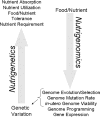Genetic and epigenetic contributions to human nutrition and health: managing genome-diet interactions
- PMID: 18755320
- PMCID: PMC5421377
- DOI: 10.1016/j.jada.2008.06.430
Genetic and epigenetic contributions to human nutrition and health: managing genome-diet interactions
Abstract
The Institute of Medicine recently convened a workshop to review the state of the various domains of nutritional genomics research and policy and to provide guidance for further development and translation of this knowledge into nutrition practice and policy. Nutritional genomics holds the promise to revolutionize both clinical and public health nutrition practice and facilitate the establishment of (a) genome-informed nutrient and food-based dietary guidelines for disease prevention and healthful aging, (b) individualized medical nutrition therapy for disease management, and (c) better targeted public health nutrition interventions (including micronutrient fortification and supplementation) that maximize benefit and minimize adverse outcomes within genetically diverse human populations. As the field of nutritional genomics matures, which will include filling fundamental gaps in knowledge of nutrient-genome interactions in health and disease and demonstrating the potential benefits of customizing nutrition prescriptions based on genetics, registered dietitians will be faced with the opportunity of making genetically driven dietary recommendations aimed at improving human health.
Figures




Similar articles
-
Personalised nutrition: how far has nutrigenomics progressed?Eur J Clin Nutr. 2013 May;67(5):430-5. doi: 10.1038/ejcn.2012.145. Epub 2012 Oct 24. Eur J Clin Nutr. 2013. PMID: 23093344 Review.
-
Genetics, Nutrition, and Health: A New Frontier in Disease Prevention.J Am Nutr Assoc. 2024 May-Jun;43(4):326-338. doi: 10.1080/27697061.2023.2284997. Epub 2023 Nov 28. J Am Nutr Assoc. 2024. PMID: 38015713 Review.
-
Personalized nutrition: nutritional genomics as a potential tool for targeted medical nutrition therapy.Nutr Rev. 2007 Jul;65(7):301-15. doi: 10.1111/j.1753-4887.2007.tb00308.x. Nutr Rev. 2007. PMID: 17695371 Review.
-
Prescribing personalized nutrition for cardiovascular health: are we ready?J Nutrigenet Nutrigenomics. 2014;7(3):153-60. doi: 10.1159/000370213. Epub 2015 Jan 27. J Nutrigenet Nutrigenomics. 2014. PMID: 25634489 Review.
-
Nutritional genomics and dietetic professional practice.Can J Diet Pract Res. 2008 Winter;69(4):177-82. doi: 10.3148/69.4.2008.177. Can J Diet Pract Res. 2008. PMID: 19063807 Review.
Cited by
-
Polymorphisms in 1-carbon metabolism, epigenetics and folate-related pathologies.J Nutrigenet Nutrigenomics. 2011;4(5):293-305. doi: 10.1159/000334586. Epub 2012 Feb 22. J Nutrigenet Nutrigenomics. 2011. PMID: 22353665 Free PMC article. Review.
-
Myelin damage due to local quantitative abnormalities in normal prion levels: evidence from subacute combined degeneration and multiple sclerosis.J Neurol. 2014 Aug;261(8):1451-60. doi: 10.1007/s00415-013-7152-3. Epub 2013 Oct 20. J Neurol. 2014. PMID: 24141733 Review.
-
Multiple system atrophy: genetic or epigenetic?Exp Neurobiol. 2014 Dec;23(4):277-91. doi: 10.5607/en.2014.23.4.277. Epub 2014 Dec 12. Exp Neurobiol. 2014. PMID: 25548529 Free PMC article. Review.
-
PhenX: a toolkit for interdisciplinary genetics research.Curr Opin Lipidol. 2010 Apr;21(2):136-40. doi: 10.1097/MOL.0b013e3283377395. Curr Opin Lipidol. 2010. PMID: 20154612 Free PMC article. Review.
-
Nutrition and Genetics in NAFLD: The Perfect Binomium.Int J Mol Sci. 2020 Apr 23;21(8):2986. doi: 10.3390/ijms21082986. Int J Mol Sci. 2020. PMID: 32340286 Free PMC article. Review.
References
-
- Garza C, Stover PJ. The role of science in identifying common ground in the GMO debate. Trend Food Tech. 2003;14:182–190.
-
- IOM. Nutrigenomics and beyond: Informing the future. Washington, DC: The National Academies Press; 2007.
-
- Stover PJ. Human nutrition and genetic variation. Food Nutr Bull. 2007;28(Suppl International 1):S101–S115. - PubMed
-
- Tishkoff SA, Verrelli BC. Role of evolutionary history on haplotype block structure in the human genome: Implications for disease mapping. Curr Opin Genet Dev. 2003;13:569–575. - PubMed
-
- Cargill M, Altshuler D, Ireland J, Sklar P, Ardlie K, Patil N, Shaw N, Lane CR, Lim EP, Kalyanaraman N, Nemesh J, Ziaugra L, Friedland L, Rolfe A, Warrington J, Lipshutz R, Daley GQ, Lander ES. Characterization of single-nucleotide polymorphisms in coding regions of human genes. Nat Genet. 1999;22:231–238. - PubMed
Publication types
MeSH terms
Grants and funding
LinkOut - more resources
Full Text Sources
Medical
Research Materials

